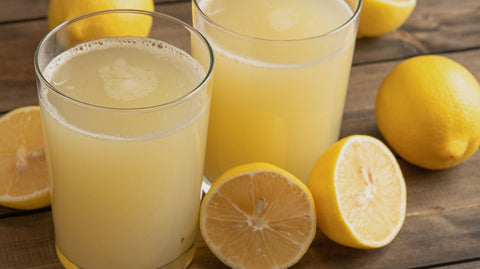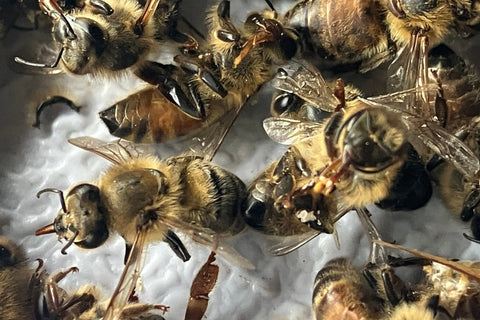There’s nothing quite like an ice-cold glass of lemonade, but what if you could make it even better? By swapping out refined sugar for raw, single-source honey from Ames Farm, you’ll create a naturally sweetened twist on a summer classic that’s just as refreshing as it is wholesome.
This honey lemonade recipe is simple, delicious, and packed with natural flavor. Whether you’re hosting a backyard barbecue, planning a picnic, or just looking for a healthier drink to enjoy on the porch, this recipe is sure to hit the spot.
At Ames Farm, we’re passionate about using real ingredients straight from nature. Our raw honey isn’t just a sweetener, it’s a flavor experience. In this post, we’ll show you how to make honey lemonade from scratch, share fun variations to try, and explain why our honey makes all the difference. Let’s stir things up!
Why Use Honey Instead of Sugar?
When it comes to sweetening your lemonade, honey is more than just a substitute for sugar, it’s an upgrade. Unlike refined sugar, which offers little more than empty calories, honey provides trace vitamins, minerals, enzymes, and antioxidants that support overall wellness. It’s a natural sweetener that not only tastes amazing but also brings real benefits to the table.
Using honey in your lemonade adds a smooth, floral depth that sugar just can’t match. Depending on the honey variety you choose, like Ames Farm’s delicate basswood or bold buckwheat, the flavor of your lemonade can shift from light and citrusy to rich and earthy. It’s a customizable experience that brings out the best in every glass.
What sets Ames Farm honey apart is its purity and origin. Our single-source honey is raw, unfiltered, and harvested from individual apiaries across Minnesota. This means every jar captures the unique taste of a specific location and bloom, giving you real flavor, not a blended generic mix. When you use Ames Farm honey in your lemonade, you’re choosing a sweetener that’s as real and natural as the lemons themselves.
What You’ll Need To Make Honey Lemonade
Making honey lemonade is wonderfully simple, and with just a few fresh ingredients and basic tools, you’ll be sipping in no time. Here’s what you’ll need:
Ingredients:
- 1 cup fresh-squeezed lemon juice (about 4–6 lemons)
- ½ cup Ames Farm raw honey (adjust to taste)
- 4 cups cold filtered water
- 1 cup warm water (to help dissolve the honey)
- Ice cubes
Optional add-ins:
- Fresh mint leaves
- A few slices of ginger
- A handful of berries
- Sparkling water (for a fizzy twist)
Recommended Honey Varieties:
- Basswood Honey: light, crisp, and floral
- Sweet Clover Honey: classic and mild
- Buckwheat Honey: dark, bold, and molasses-like
- Each variety from Ames Farm offers a unique flavor profile that can influence the overall taste of your lemonade. Try experimenting to find your favorite!
Tools:
- Citrus juicer or reamer
- Measuring cups and spoons
- A mixing spoon
- Large pitcher
- Strainer (optional, for pulp-free lemonade)
With everything gathered, you’re ready to create a refreshing drink that’s naturally sweet and bursting with flavor.
Step-by-Step: How to Make Honey Lemonade
This honey lemonade recipe is easy to follow and takes just minutes to prepare. The key is gently warming the honey to help it blend smoothly without destroying its natural enzymes. Follow these steps for the perfect balance of sweet and tangy.
Step 1: Juice the Lemons
Start by juicing enough lemons to get about 1 cup of fresh lemon juice. This usually takes 4 to 6 medium lemons. If you prefer a pulp-free lemonade, strain the juice to remove seeds and excess pulp.
Step 2: Dissolve the Honey
In a small bowl or saucepan, combine ½ cup of Ames Farm raw honey with 1 cup of warm water (not boiling, just warm enough to dissolve the honey). Stir until the honey is fully dissolved. This creates a simple honey syrup that blends easily into the lemonade.
Tip: Avoid using hot or boiling water to preserve the beneficial enzymes and nutrients in raw honey.
Step 3: Combine Ingredients
In a large pitcher, mix the freshly squeezed lemon juice, the honey syrup, and 4 cups of cold filtered water. Stir well to combine.
Step 4: Taste and Adjust
Give your lemonade a quick taste test. You can add more honey for sweetness or more lemon juice for extra tang. Customize it to your liking.
Step 5: Chill and Serve
Add plenty of ice cubes and let the lemonade chill for at least 15–20 minutes in the fridge before serving. This allows the flavors to fully meld together.
Optional Enhancements:
- Add a few sprigs of fresh mint for a cooling herbal note.
- Drop in some sliced ginger for a spicy twist.
- Replace some of the cold water with sparkling water for a fizzy version.
- Garnish with lemon slices or edible flowers for an extra-pretty presentation.
Now that your honey lemonade is ready, let’s look at a few fun variations you can try next!
Flavor Variations to Try
One of the best things about homemade honey lemonade is how easy it is to customize. With just a few simple ingredients, you can create flavor variations that suit every mood, event, or season. Here are some delicious twists to inspire your next batch:
1. Mint Honey Lemonade
Add a handful of fresh mint leaves to your pitcher and gently muddle them before adding the lemon juice and honey mixture. The result is a cool, herbal flavor that’s extra refreshing.
2. Lavender Honey Lemonade
Infuse 1 tablespoon of dried culinary lavender in your warm honey water mixture. Let it steep for 5–10 minutes, then strain before adding to the lemon juice. Lavender pairs beautifully with light varieties like Ames Farm’s basswood honey, creating a floral, calming drink.
3. Ginger-Honey Lemonade
Grate a small piece of fresh ginger (about 1 teaspoon) and steep it in the warm water with honey. This adds a subtle spicy warmth and makes a fantastic immunity-boosting version. Pair with Ames Farm’s buckwheat honey for a bold flavor combo.
4. Sparkling Honey Lemonade
Swap out 2 cups of cold water for sparkling water to give your lemonade a bubbly lift. This is a fun twist for brunches, parties, or a fancy treat just for you.
5. Berry-Infused Honey Lemonade
Add a handful of crushed raspberries, strawberries, or blueberries to your pitcher before serving. Let it sit for a while so the berry flavor infuses into the drink. This works great with Ames Farm’s clover honey, which has a light and neutral sweetness.
What To Pair With Honey Lemonade
Honey lemonade is a versatile beverage that pairs beautifully with a wide range of foods, especially those with light, fresh flavors. For a simple afternoon snack, serve it alongside fruit trays, veggie platters, or cheese boards. The tartness of the lemon and the natural sweetness of Ames Farm honey perfectly complement soft cheeses like brie or goat cheese, as well as crisp apples and juicy berries. It’s also an excellent match for light salads topped with citrus vinaigrette or honey-glazed nuts.
Hosting a get-together? Honey lemonade is the ideal companion to grilled foods and picnic fare. Serve it with herbed chicken, veggie skewers, or sandwiches made with fresh herbs and seasonal ingredients.
Health Benefits of Honey Lemonade
Honey lemonade isn’t just refreshing, it’s also packed with natural health benefits. Lemons are rich in vitamin C, which supports your immune system and helps the body fight off colds and infections. They also aid digestion, balance pH levels, and act as a gentle detoxifier.
When combined with water, lemon juice becomes a hydrating and revitalizing drink that’s much healthier than sugary sodas or artificially flavored beverages.
By using raw, single-source honey from Ames Farm, you’re also adding nutrients and antioxidants that support overall wellness. Raw honey contains enzymes, amino acids, and antibacterial properties that can soothe sore throats, boost energy levels, and even improve skin health.
Unlike refined sugar, honey has a lower glycemic index, which means it’s less likely to spike your blood sugar. Whether you’re sipping it in the morning to start your day or enjoying it as a mid-afternoon pick-me-up, honey lemonade offers a naturally nourishing option your body will thank you for.
Why Choose Ames Farm Honey for Your Lemonade?
When it comes to making honey lemonade, the quality of your ingredients matters, and that’s why Ames Farm honey is the perfect choice. Our raw, single-source honey is harvested from individual apiaries across Minnesota, capturing the unique flavor of each location and bloom.
Unlike mass-produced blends, Ames Farm honey is unfiltered and never overheated, preserving its natural enzymes, antioxidants, and rich floral notes. Whether you prefer a light, delicate variety like basswood or a bold, earthy option like buckwheat, each jar brings a distinct character that elevates your lemonade from simple to sensational.
By choosing Ames Farm, you're not just sweetening your drink, you're supporting sustainable beekeeping and enjoying honey the way nature intended.
Final Thoughts About Honey Lemonade
Honey lemonade is a simple pleasure that brings together the brightness of fresh lemons and the natural sweetness of real honey. It’s easy to make, endlessly customizable, and a refreshing way to treat yourself while staying hydrated and healthy. Whether you're enjoying it solo or sharing a pitcher with friends, this recipe is a summer staple worth savoring.
Ready to make your own batch of honey lemonade? Start with the best, Ames Farm honey. Each variety is bottled straight from the hive, offering traceable origin and unmatched purity. Explore their full selection of single-source honeys here and discover which floral notes speak to your taste. Your lemonade (and your taste buds) will thank you.
Frequently Asked Questions About Honey Lemonade
How long does honey lemonade last in the fridge?
Homemade honey lemonade will stay fresh in the refrigerator for up to 5 days. Store it in a sealed glass pitcher or bottle and give it a good stir before serving, as the honey may settle.
Do I need to heat the honey before mixing it?
You don’t need to boil it, just warm the water slightly (not hot!) to help dissolve the honey. This keeps the beneficial enzymes and nutrients in raw honey intact.
What’s the best honey variety for lemonade?
Light and floral honeys like basswood or dutch clover honey from Ames Farm pair wonderfully with citrus flavors.


